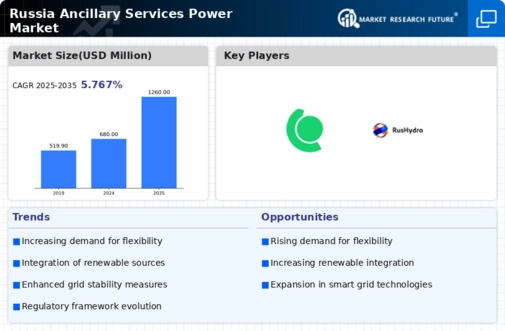Growing Demand for Grid Stability
The increasing complexity of the power grid in Russia necessitates enhanced grid stability, which is a primary driver for the ancillary services-power market. As the integration of renewable energy sources expands, the need for ancillary services to manage fluctuations in supply and demand becomes critical. In 2025, the Russian power grid is projected to experience a 15% increase in demand for ancillary services, driven by the growing reliance on intermittent renewable sources. This demand is likely to push utilities to invest in advanced technologies and services that ensure reliability and efficiency. Consequently, the ancillary services-power market is expected to expand significantly, as stakeholders seek solutions to maintain grid integrity and support the transition towards a more sustainable energy landscape.
Increased Focus on Energy Efficiency
The growing emphasis on energy efficiency in Russia is emerging as a key driver for the ancillary services-power market. As businesses and consumers seek to reduce energy consumption and costs, there is a corresponding demand for ancillary services that support energy management and optimization. In 2025, it is estimated that energy efficiency initiatives will lead to a 12% reduction in peak demand, thereby increasing the need for ancillary services that can effectively manage these changes. This focus on efficiency not only benefits consumers but also enhances the overall stability of the power grid. As a result, the ancillary services-power market is likely to see increased investment and innovation aimed at providing solutions that align with energy efficiency goals.
Investment in Smart Grid Technologies
Investment in smart grid technologies is transforming the ancillary services-power market in Russia. These technologies facilitate real-time monitoring and management of electricity flows, enhancing the efficiency of ancillary services. In 2025, it is estimated that investments in smart grid infrastructure will reach approximately $3 billion, reflecting a growing recognition of the need for modernization. This shift not only improves operational efficiency but also enables better integration of renewable energy sources. As utilities adopt smart grid solutions, the ancillary services-power market is likely to benefit from increased demand for services such as frequency regulation and voltage support, which are essential for maintaining grid stability.
Regulatory Support for Ancillary Services
Regulatory frameworks in Russia are increasingly supportive of the ancillary services-power market, creating a conducive environment for growth. Recent policy initiatives aim to enhance the reliability of the power system and promote the development of ancillary services. In 2025, it is anticipated that new regulations will mandate a minimum level of ancillary services to be procured by utilities, potentially increasing market size by 20%. This regulatory push is expected to encourage investments in innovative solutions and technologies that enhance service delivery. As a result, the ancillary services-power market is likely to see a surge in participation from both traditional and new market players, fostering competition and innovation.
Rising Penetration of Distributed Energy Resources
The rise of distributed energy resources (DERs) in Russia is significantly impacting the ancillary services-power market. As more consumers and businesses adopt solar panels, battery storage, and other DERs, the need for ancillary services to manage these resources becomes increasingly important. By 2025, it is projected that DERs will account for over 10% of total electricity generation in Russia, necessitating enhanced coordination and management. This trend is likely to drive demand for ancillary services that facilitate the integration of DERs into the grid, such as demand response and energy storage solutions. Consequently, the ancillary services-power market is expected to evolve, offering new opportunities for service providers and enhancing overall grid resilience.

















Leave a Comment